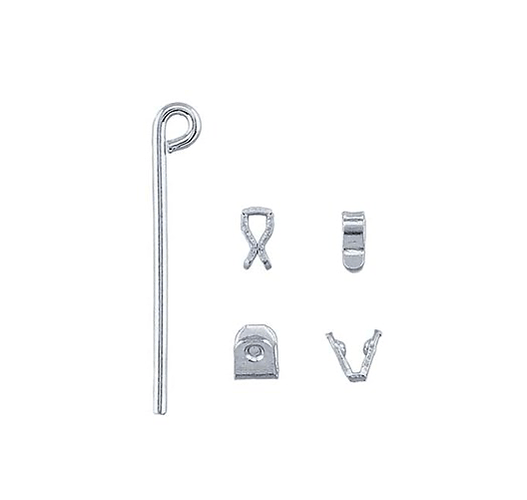I made a rather large pair of sterling mandala earrings. To close them I purchased a straight post, joint ad catch set. It’s very delicate compared to the earring I’m attaching it to guessing it’s about 26 gauge. When using this set, I often end up melting one of the components. Any suggestions? I posted an image below of the set , which includes side views of the catch and joint. Thanks.
No magic advice here, but this is what I do. I pre-melt a little bit of easy solder onto the bottom of the pin catch and latch. Then I draw a line with a permanent marker to help me remember where the parts are supposed to line up. The marker will burn off fairly fast, but that will hopefully give me enough time to solder things where they’re supposed to go. I’ll add only a little bit of flux and watch very closely while I heat it all up. The window before the solder melts and the pin finding melts is very small.
Whenever possible I heat from below as that helps to keep the parts from melting.
I don’t much experience with paste solder, but that might be a good solution here. Others can say if that’s a good idea or not.
Hope that helps!
Jeff
Hi,
also, you would be feathering the heat on the earring, not the components…the heat from the earring metal will transfer to the component metal…
if you focus heat onto the components, being very thin, they will heat up (and possibly melt) before the earring metal mass gets up to soldering tempurature….
julie
Thanks Jeff
That’s helpful. Sweat solder the latch and catch, got it. I agree that the hard part is melting those 2 thin findings. I’m not a fan of paste solder so I’ll use a tiny piece of easy solder to flow on the bottom of each piece. Heating from the bottom is interesting idea. Not sure I can do that in this case but you’ve gotten me thinking of how to set this up. The main body of the earring is 24 or 20 gauge and has lots of surface area compared to the tiny pieces being soldered on. I see widlzrd1 is addressing this in the next answer. Thanks SO much!
Hi Julie,
Thanks for the suggestion. I’m guessing you mean by feather heating is quickly moving the flame off and on the main body of the earring ? I think I’ll hold the thin components with tweezers to create a heat sink and try to get solder flow air the right moment. OR I’ll lay the earring flat on a board, feather heat the earring body, and move the sweat soldered component in a the right moment without the use of a tweezer.
I appreciate the help! Thanks.
Joanne
I wanted to try to answer them too but true…theres a fine line to when it all melts and u fail a lot hahaha
Been there, Done that! LOL!
No coffee before soldering, make sure I’m well rested, no wine the night before and have plenty of extra findings on hand. Ah for the love of this earring!
Hi,
also, you can use a locking tweezer to hold the mandala upright, and a third hand to hold the component…thus eliminating the need to control 2 hands at the same time (i have issues with that, haha!)…so you can focus on the heat…heat opposite the catch position…
julie
Personally I would spring for a higher quality finding. A “heavy” joint, supplied with special rivets and “heavy” catch. Be sure to orient the joint a few degrees above the catch so that it has to be “hooked” into the catch. This way if catch opens the pinstem doesn’t come out of the catch.
I agree on easy solder. I dislike paste solder. It’s designed for soldering in a hydrogen oven and a few specialized pieces such as filigree.
